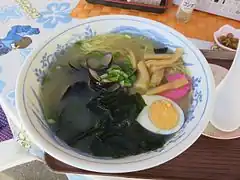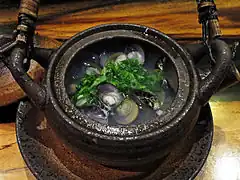| Corbicula japonica | |
|---|---|
.jpg.webp) | |
| Shijimi (Corbicula japonica) being sold in Kuwana City, Japan | |
| Scientific classification | |
| Domain: | Eukaryota |
| Kingdom: | Animalia |
| Phylum: | Mollusca |
| Class: | Bivalvia |
| Order: | Venerida |
| Superfamily: | Cyrenoidea |
| Family: | Cyrenidae |
| Genus: | Corbicula |
| Species: | C. japonica |
| Binomial name | |
| Corbicula japonica Prime, 1864 | |
Corbicula japonica is an edible species of brackishwater clam, a bivalve mollusk in the family Cyrenidae, the basket clams. Its common names include Japanese basket clam, Japanese blue clam, and shijimi (its Japanese name).[1][2]
Summary
Japanese basket clams settle at the mouths of rivers in brackish water. During low tide, people are able to see them in tidal flats and collect them for food. Their shells are roughly 30-35mm and are reddish-brown while young, turning black as they mature. Their shells are glossy and have a tendency to grow concentric circles from their base, similar to Corbicula fluminea. The inside of their shells is purple when they are young and becomes white as they mature. Their reproduction is based on gonochorism.
Culinary Use
Japan
In Japan, the clam is usually called shijimi, though this technically refers to the Corbicula genus in general. The more precise name is yamato-shijimi ("Japanese corbicula"). Shijimi and asari, (Lajonkairia lajonkairii) are two of the most common clams used in soups and tsukudani (simmered seafood).[3]
See also
References
- ↑ "Corbicula japonica, Japanese corbicula : fisheries". www.sealifebase.ca. Retrieved 2020-03-31.
- ↑ Ishihara, Yukio; Ueta, Kazumi; Bito, Tomohiro; Takenaka, Shigeo; Yabuta, Yukinori; Watanabe, Fumio (2013). "Characterization of vitamin B12 compounds from the brackish-water bivalve Corbicula japonica". Fisheries Science. 79 (2): 321–326. doi:10.1007/s12562-013-0596-7. S2CID 15171596.
- ↑ Kasai, Akihide; Toyohara, Haruhiko; Nakata, Akiko; Miura, Tsunehiro; Azuma, Nobuyuki (2006-01-01). "Food sources for the bivalve Corbicula japonica in the foremost fishing lakes estimated from stable isotope analysis". Fisheries Science. 72 (1): 105–114. doi:10.1111/j.1444-2906.2006.01123.x. ISSN 1444-2906. S2CID 26905032.
_2014.jpg.webp)


.jpg.webp)